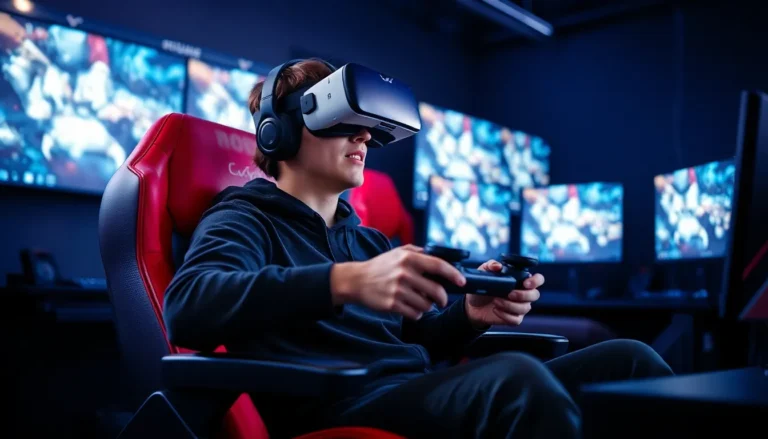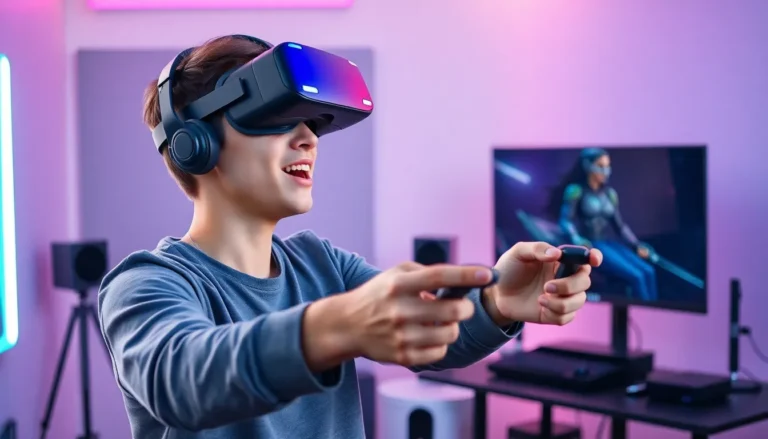Imagine stepping into a world where learning feels like an epic adventure. With VR educational games, students don’t just read about history; they can walk through ancient civilizations, interact with historical figures, and maybe even dodge a few dinosaurs along the way. Who knew that geometry could be mastered while battling alien invaders in outer space?
Table of Contents
ToggleOverview of VR Educational Games
VR educational games reshape the learning landscape by providing immersive experiences that foster engagement. These games encourage exploration and creativity, enabling students to connect with educational content in exciting ways.
Definition and Purpose
VR educational games combine technology and learning, creating interactive environments where students can explore subjects firsthand. These games aim to deepen understanding by allowing students to visualize complex concepts and practice skills in realistic settings. For instance, learners can explore ancient civilizations or simulate scientific experiments, enhancing retention and comprehension. The immersive nature of VR captivates attention, making education more enjoyable. Ultimately, these games serve as valuable tools in modern education, bridging gaps between theory and practice.
Evolution of VR Technology in Education
VR technology in education has advanced significantly over the past decade. Initial applications focused on basic simulations, while recent developments integrate sophisticated graphics and responsive interfaces. Educational institutions increasingly adopt VR, utilizing devices like headsets and mobile platforms. The growth of accessible content and affordable equipment contributes to widespread use in classrooms. As a result, educators have embraced VR as an innovative approach to teaching. This evolution highlights the commitment to enhancing the learning experience and preparing students for a technology-driven future.
Benefits of VR Educational Games

VR educational games transform the learning landscape by delivering immersive and interactive experiences. These advantages significantly enhance student engagement and understanding.
Enhanced Engagement and Interactivity
VR educational games captivate learners through engaging visuals and interactive scenarios. Students experience content firsthand, participating in activities that evoke excitement and curiosity. Immersion in historical events or complex scientific concepts encourages deeper exploration. Engagement levels soar when students navigate virtual worlds, fostering collaboration and social interactions. Teachers often report increased participation rates, attributing this to the immersive nature of VR. Interactive elements, such as problem-solving tasks, make learning enjoyable and meaningful.
Improved Retention and Learning Outcomes
Retention rates soar among students utilizing VR educational games. Studies show learners grasp information better when experiences are interactive and memorable. The combination of visual stimuli and hands-on activities helps students retain complex information effectively. Realistic simulations promote critical thinking skills, enabling students to apply knowledge in practical scenarios. Assessment data reveal that students using VR consistently outperform their peers in traditional settings. This enhanced understanding leads to improved academic performance, making VR a valuable educational tool.
Popular VR Educational Games
Several VR educational games have emerged, each offering unique features that enhance the learning experience.
Game 1: Overview and Features
“Classroom Aquatic” immerses players in a school setting where they become students in a classroom. Players complete tasks like answering questions posed by their teacher, an engaging way to learn marine biology. Through exploration, students learn about ocean habitats and the importance of marine conservation. The game encourages teamwork, allowing players to interact and collaborate on research projects. Experiencing this environment transforms traditional learning into an interactive adventure.
Game 2: Overview and Features
“Virry VR” transports users to various wildlife habitats where they can observe animals in their natural environments. This simulation enhances knowledge about biodiversity and conservation efforts. Players can interact with animals, learning their behaviors and roles within ecosystems. Engaging with wildlife stimulates curiosity and motivates students to further explore ecological topics. This game exemplifies how immersive environments can create memorable learning moments.
Game 3: Overview and Features
“ENGAGE” is a versatile platform designed for virtual classrooms and training sessions. Instructors have the ability to create lessons in immersive 3D environments, making complex subjects more approachable. Features include virtual field trips and collaborative projects that further promote engagement among students. By utilizing this platform, educators can tailor content to students’ needs, facilitating personalized learning experiences. Overall, “ENGAGE” illustrates the power of VR in reshaping educational methodologies.
Challenges and Limitations
Challenges and limitations exist in the realm of VR educational games, impacting their widespread implementation and effectiveness in learning environments.
Technical Barriers
Technical barriers pose significant challenges for educators and students. High-quality VR experiences often require powerful hardware, including advanced graphics cards and high-resolution displays. Limited access to such devices restricts many institutions, especially those with tight budgets. Additionally, software compatibility issues can hinder effective usage, creating a barrier to seamless integration. Educators may face difficulties in setting up and maintaining the technology, requiring technical support that schools may not have readily available. Connectivity issues can also disrupt the immersive experience, leading to frustration among users. Overall, these technical challenges hinder the potential benefits that VR educational games promise to deliver.
Accessibility Issues
Accessibility issues also affect the reach of VR educational games. Students with disabilities may find it challenging to engage fully with VR content. Many games lack options for adaptive controls and other assistive technologies. This exclusion limits the learning opportunities for students who may benefit significantly from immersive educational experiences. Furthermore, the physical requirements of VR, such as mobility and space, sometimes create obstacles in typical classroom settings. Economic disparities further accentuate the problem, as not all institutions can invest in the necessary equipment. A focus on inclusivity is crucial for ensuring all learners can benefit from VR in their educational journeys.
Future Trends in VR Educational Games
The landscape of VR educational games continues to evolve rapidly. Emerging technologies promise enhancements that will further enrich the learning experience in schools and beyond.
Advancements in Technology
Recent advancements in VR technology focus on improving realism and interactivity. Developers now utilize artificial intelligence to create more dynamic learning environments where students can interact meaningfully with characters and landscapes. Enhanced graphics and sound design contribute to deeper immersion, making experiences lifelike. Affordable VR headsets provide broader access, allowing more schools to integrate these tools into their classrooms. Battery life improvements and user-friendly interfaces streamline usability for both teachers and students. Innovations like haptic feedback gear heighten sensory engagement, resulting in education that captivates and retains attention.
Potential for Broader Adoption
The potential for broader adoption of VR educational games is significant. Increased funding from educational institutions enhances resource availability, including training for educators on effective VR implementation. Public-private partnerships also play a key role, fostering the development of affordable, high-quality educational content. Growing recognition of the effectiveness of VR in enhancing critical thinking and retention motivates schools to adopt these tools. Societal shifts towards digital learning environments further support this trend, as parents and educators seek innovative methods to engage students. As awareness of VR’s benefits spreads, expectations for widespread integration in curricula rise.
VR educational games are revolutionizing how students engage with learning material. By immersing learners in interactive environments, these games make complex concepts more accessible and enjoyable. The blend of technology and creativity fosters a deeper understanding of subjects while encouraging collaboration and critical thinking.
As VR technology continues to advance, the potential for these games to transform educational experiences grows. Addressing the challenges of accessibility and affordability will be crucial in ensuring that all students can benefit from this innovative approach. The future of education is bright with the integration of VR, promising to shape a generation of learners who are more engaged and prepared for a technology-driven world.





